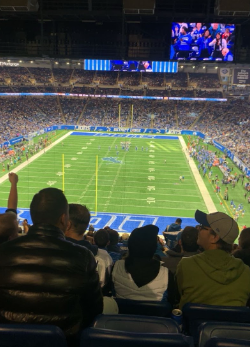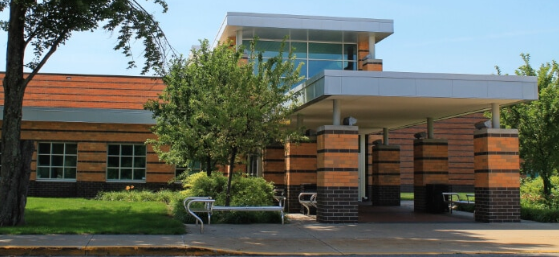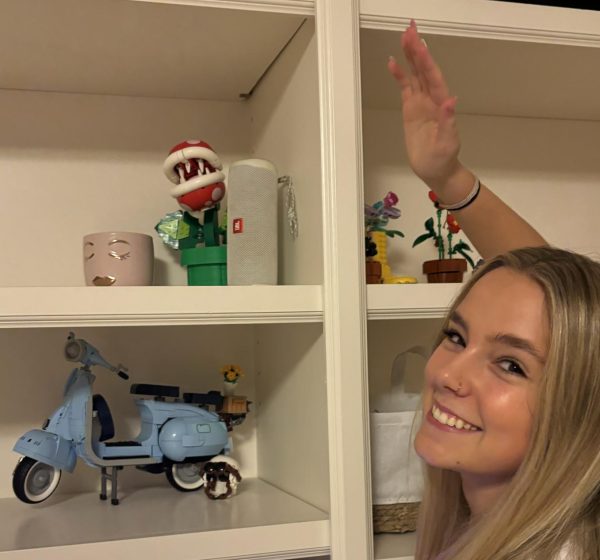Ignoring the red flags of human trafficking
Holland residents respect a red flag at the beach warning of dangerous currents.
April 21, 2023
When there’s a red flag warning at the Holland State Park, we don’t challenge ourselves to swim out as far as we can. Generally we manage our risks. But when it comes to social media, we ignore the flag. We ignore the waves. We ignore our parents’ warnings. While it is an incredibly powerful tool for connecting with others and staying informed, social media poses a variety of consequences. Users set themselves up for risks like cyberbullying, avoidable distractions, and lowered self-esteem. While those are real and active concerns, there’s a quiet and growing danger that also uses social media to drive its functioning: human trafficking.
Recently, West Ottawa Equality Now (WENOW) invited the nonprofit organization Warning Lights to elevate human trafficking awareness at West Ottawa High School. WENOW hosted a seminar for anyone to attend in the South LGI room on March 16. Warning Lights’ founder Jenn Amo presented her curriculum, which works to educate and empower young people to protect themselves and others from this crime. Amo candidly stated that as human trafficking and social media become more closely entwined, students are seriously at risk.
Human trafficking is the second fastest growing crime in the nation. According to the National Human Trafficking Hotline, “Human trafficking is the business of stealing freedom for profit.” The majority of cases involve forcing, defrauding, or coercing victims into sex work. However, other predators lie, assault, threaten, or manipulate victims into working under inhumane or illegal conditions.
Human trafficking is modern day slavery. All ages, genders, ethnicities, and socio-economic statuses can fall prey to human trafficking. By the same token, human trafficking predators aren’t limited to any stereotype either. Sr. Jack O’Brien, who came to the seminar, said, “I think we all have an idea of a middle-aged man being the perpetrator, but Amo really emphasized that people of all types of backgrounds, genders, races, and status levels can be traffickers.”
After the COVID-19 pandemic, 90% of human trafficking cases start on social media. All social media users put themselves at risk, especially those who have followers they don’t personally know.
A common misconception limits human trafficking crimes to a stranger kidnapping a victim and forcing them into the crime. In reality, human trafficking is a relationship-based crime that most frequently happens right in the victim’s home. The predator often isn’t “stranger danger.” A predator gains a victim’s trust and learns about their insecurities. This can be a family member or supposed friend that a victim meets online. Although predators seem trustworthy at first, they flip when their victims fall prey. Many predators use social media to catfish and then ensnare victims.
Amo described a common scenario that’s happening to youth everywhere:
An adult predator makes a fake social media account presenting themself as a peer. Then, they follow someone young and vulnerable. The predator starts to privately message the victim, who believes that the predator is a potential friend or relationship from another school district in the area, not a 43-year-old woman in Texas. Slowly, the victim shares personal information, and the predator learns more and more. Meanwhile, they stalk the victim’s followers and page to learn the identities of their friends and family. The predator works to earn their victim’s trust. Slowly, the victim tells the predator their insecurities and secrets, thinking they’re a trustworthy peer who has genuine intentions for a relationship. In many cases, the predator eventually convinces the victim to send sexually explicit pictures. Once the predator has that final piece of leverage, the predator flips.
The predator has now gained information and pictures that could damage the victim’s life if shared. The predator then uses the victim. The predator threatens the victim to do what they say, or they will share the pictures or information with the victim’s friends and family.
The victim feels like they can’t tell anyone, because the predator makes the victim believe it’s their fault. Predators are good at making the victim feel this way. They continue to build on the insecurities of their victims and the victim’s fear takes over. The victim does whatever the predator tells them.
Predators are skilled manipulators. The manipulation continues as the predator convinces the victim that they have no one to turn to or tell. The most common sign that a person is a victim of human trafficking is a change in behavior that leads to isolation. The predator pushes guilt onto the victim, which makes telling a trusted adult seemingly impossible. The predator wins and continues to use the victim.
Human trafficking isn’t an issue to push aside; it’s happening within the community. In Michigan, human trafficking is the second largest criminal enterprise. Since 2007, the Human Trafficking Hotline identified 2,455 cases and 5,367 victims of human trafficking in Michigan. The average victim’s age is thirteen. WENOW club leader sr. Mariah Stewart said, “I hope that students have a wake up call and understand this crime is happening way too close for comfort.”
In an increasingly virtual world, students must choose safety against human trafficking. After all, the crime will only continue to grow. During the seminar, Amo stressed the importance of only following people you know face to face. She also encouraged students to report any suspicions of human trafficking cases, and she pledged herself as a trusted adult to turn to. Amo said, “This invitation to help you does not end today. I’m here for you. Do you hear me?”
Social media isn’t going away, and human trafficking continues to take more victims. Students must equip themselves with knowledge and take preventative measures in order to combat themselves against the crime.
Like Stewart said, “Knowledge is power when it comes to human trafficking. Ignoring the problem won’t make it go away. We must educate ourselves to help those in need and keep ourselves safe.”
Human Trafficking Hotline: 1-888-373-7888
Hearing and speech-impaired individuals should dial 711. You can also send an SMS text to 233-733 or start a live chat on their website.
Warning Lights: https://warninglights.org/















